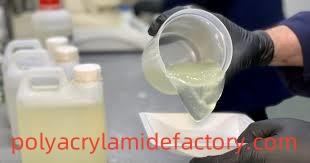How Anionic Polyacrylamide Emulsion Optimizes Water Treatment Processes

anionic polyacrylamide emulsion plays a critical role in water treatment by enhancing the flocculation and sedimentation processes. It is widely used in various industries, such as municipal wastewater management, industrial effluent treatment, and mining operations. The ability of this emulsion to bind with suspended particles in water helps in improving water clarity, making it a valuable asset in your water treatment processes.
The application of anionic polyacrylamide emulsion involves the addition of the polymer to water in order to form large, easily separable aggregates. These aggregates or flocs trap fine particles and help them settle out of the water. This process is beneficial not only for wastewater treatment but also for removing impurities from water sources, ensuring cleaner water for reuse or safe discharge.
1. Correct Dosage and Mixing Process
The effectiveness of anionic polyacrylamide emulsion depends largely on the dosage applied and the efficiency of its mixing. Over- or under-dosing can lead to ineffective flocculation, causing either excess chemical residue or insufficient removal of contaminants. A balanced dosage is crucial, and careful attention must be paid to mixing the polymer evenly into the water. A slow and controlled addition helps avoid the risk of forming unstable flocs or creating too many small particles that will not settle.
2. Adjusting for Water Quality
The quality of the water being treated should be taken into account when applying anionic polyacrylamide emulsion. For example, in water with high turbidity or with a significant amount of organic matter, a higher concentration of the polymer might be required. Conversely, for water with fewer particles, a lower dosage may suffice. By adjusting the concentration to match the specific water quality, you can optimize the effectiveness of the emulsion, ensuring the most efficient removal of solids and organic material.
3. Temperature Sensitivity
Anionic polyacrylamide emulsions are sensitive to temperature changes, and their performance can vary depending on the environmental conditions. In colder temperatures, the emulsion may be less effective at agglomerating particles, requiring slightly higher doses. On the other hand, in warmer conditions, the polymer may work more efficiently, and adjustments to the dosage may be needed. Understanding the temperature range that works best for your specific application can help achieve optimal results.
4. pH Level Considerations
Another factor that impacts the effectiveness of anionic polyacrylamide emulsion is the pH level of the water. For optimal flocculation, it is important to adjust the pH to an ideal range, as both acidic and alkaline conditions can affect the polymer's ability to bond with suspended particles. Regular monitoring of the pH during the treatment process and adjusting it as needed ensures that the emulsion will perform efficiently.
5. Batch vs. Continuous Process
Whether you are using a batch or continuous water treatment system will influence how you apply anionic polyacrylamide emulsion. In batch systems, the emulsion is added at the beginning of the treatment process, and the water is then agitated to encourage flocculation. In continuous systems, the polymer is introduced into the flow of water at a constant rate. Both systems require careful calibration to ensure the polymer is applied effectively, but continuous processes may require more sophisticated equipment for precise dosage control.
6. Integration with Other Chemicals
In many industrial applications, anionic polyacrylamide emulsion is used in combination with other chemicals, such as coagulants, to enhance the overall flocculation process. Coagulants help neutralize the charges of particles, making them more susceptible to flocculation. However, the addition of multiple chemicals requires careful management to ensure that they do not counteract each other. Collaborating with experts or conducting trials to optimize chemical combinations can enhance the overall performance of your water treatment system.
The use of anionic polyacrylamide emulsion in water treatment not only aids in contaminant removal but also supports industries in achieving their environmental and sustainability goals. By improving the quality of treated water, it allows for better water recycling, reduces the environmental footprint of wastewater discharge, and ensures compliance with industry standards.
At Hengfeng, we specialize in providing high-quality anionic polyacrylamide emulsion products tailored to the specific needs of various water treatment applications. Visit https://www.polyacrylamidefactory.com/product/water-treatment/anionic-polyacrylamide-powder.html to learn more about how our solutions can optimize your water treatment processes.
- Art
- Causes
- Crafts
- Dance
- Drinks
- Film
- Fitness
- Food
- Παιχνίδια
- Gardening
- Health
- Κεντρική Σελίδα
- Literature
- Music
- Networking
- άλλο
- Party
- Religion
- Shopping
- Sports
- Theater
- Wellness


